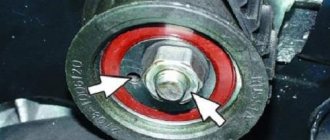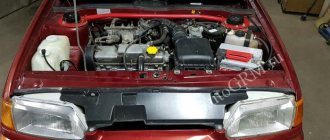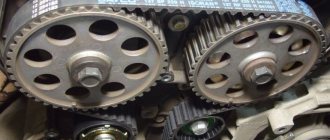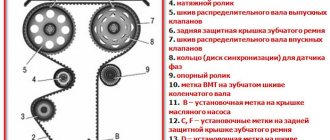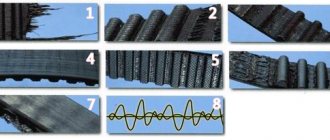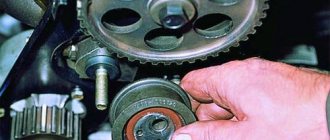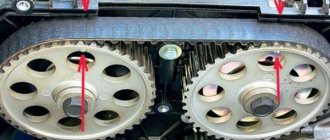A slightly battered VAZ 2110 with an 8-valve engine, replacing the timing belt, tension pulley and pump. There are 150 thousand kilometers on the odometer, but judging by the condition, it has definitely been damaged a couple of times. The last replacement of the timing belt, according to the client, was almost 50 thousand km ago, immediately after the purchase. The frequency of replacing the timing belt on VAZ 2110 8-valve engines is 60 thousand kilometers or four years of operation. The replacement interval can be increased to 80 thousand kilometers, with periodic monitoring of the condition of the gas distribution mechanism elements.
If the timing belt on an eight-valve VAZ 2110 engine breaks, the valve does not bend.
Belt faults
Malfunctions of the timing belt can arise as a result of its long-term operation, and can also be the result of incorrect adjustment or malfunctions of the pump or tension roller. These include:
- violation of the integrity of the belt (cracks, delamination);
- deformation;
- belt break.
If any of the specified malfunctions are detected, the belt must be replaced.
Why change the belt?
In accordance with the list of routine maintenance for the VAZ 2110, the timing belt must be changed after every 60-75 thousand kilometers, however, here you also need to take into account the conditions of its operation, and this is:
- temperature changes;
- oil getting on the belt;
- problems with the tension roller;
- faulty pump.
All this will inevitably lead to damage.
It is necessary to inspect at least once a month:
- belt (determining its integrity);
- tension roller ;
- water pump gear.
And although on 8-valve VAZ engines, the valve does not bend when the belt breaks, this breakdown can damage the pump or generator.
Features of labeling
Before installing another timing belt, it is better to set the crankshaft and camshaft to the specified marks from the very beginning. We set the gears to 0 position. Points A, B, C, D, E, F must match as shown in the picture. After this, you need to set the marks on the camshafts and the belt casing in the same position.
To check the location of the crankshaft, remove the plug from the box, which is installed under the thermostat, and look for the flywheel. If the marks on the camshaft and the casing match, then there should be a match in the cut on the flywheel and on the metal casing.
All alignments must be clear, the marks must match for proper operation of the belt. After the mark is installed on the flywheel, it must be fixed in this position so as not to break off the thread. And then, as mentioned, you can begin to tension and adjust the timing belt.
Timing belt price
The price of a VAZ 2110 timing belt, depending on the manufacturer, can vary from 400 to 1000 rubles. The tension roller costs about the same, which is recommended to be changed along with the belt. The cost of replacing these timing drive elements is 600-1000 rubles.
To save money, you can replace the belt and roller yourself. There is nothing complicated in this procedure, and no special tools are required. You just need to purchase spare parts.
The table below shows timing belt models for the 8-valve VAZ 2110 from different manufacturers, indicating their catalog numbers.
| TIMING BELT VAZ 2110 (8 VALVES) | |
| AVTOVAZ | 2112-1006040 |
| BOSCH | 1987949559 |
| CONTI | CT996 |
| CONTITECH | CT 996 |
| GOODYEAR | G1535 |
| GATES | 5539 |
| FLENNOR | 4428 |
| LUZAR | LTB0112 |
| LYNX | 136CL254 |
| PILENGA | CTP0996 |
| OPTIBELT | ZRK1538 |
| TENSION ROLLER | |
| AVTOVAZ | 21120-100612000 |
Replacement
- keys for 10, 13, 17;
- key for rotating the roller;
- flat screwdriver;
- wheel wrench;
- jack;
- a little engine oil to lubricate the tension roller.
1. Place the car on level ground and put it in gear.
2.Using a 10mm wrench, unscrew the bolts securing the timing case.
3. Loosen the generator belt tensioner using a 13mm wrench. Remove the belt.
4. We check the marks on the camshaft gear and the protrusion on the rear cover of the belt housing.
5.If they do not match, you need to turn the crankshaft until they match. This can be done by rotating the front wheel, jacking it up first, or turning the crankshaft with a 17mm wrench using the crankshaft pulley bolt (the gear must be engaged).
6.Behind the 4th cylinder on the clutch housing there is a rubber plug. We open it by prying it off with a screwdriver. Below it you can see the flywheel crown, which also has a mark. It should coincide with the triangular cut located on the crankcase to the left of the flywheel.
7.If they do not match, you need to loosen the tension roller, turn it to the left, thus loosening the belt, and remove it from the camshaft gear.
8.Using a 17mm wrench, turn the crankshaft as described above until all the marks match.
9.We immobilize the flywheel by locking it with a screwdriver in the hole where the plug was located.
10.Using a 17mm wrench, unscrew the bolt securing the generator pulley.
11.Behind it there is a crankshaft pulley onto which the belt to be replaced is placed.
12.Remove the old one and put on the new timing belt, starting with the crankshaft gear.
13. We fasten the generator pulley by putting a belt on it. Let's pull it on.
14. We dismantle the old tension roller, install a new one, lubricating it with oil on both sides.
15. We tension the timing belt by turning the tensioner roller to the right (if there is no special key, you can insert two suitable pins into the holes and secure with a screwdriver or other similar object). The tension should be 1.5-2 kgf. If you don’t have a tool to measure the tension, we do it the old proven way. The optimal tension is when one plane of the belt can be rotated horizontally by 90 degrees by holding your fingers in the middle between the crankshaft and camshaft gears.
Honda GC 135 engine analysis
We directly disconnect the engine from the unit (remove the pulleys, starter flywheel, frame, etc.), we get the following:
We unscrew the cover bolts, pry the cover evenly around the perimeter (it sits on the sealant) and remove it, we get the following:
We remove the magneto and flywheel (lock the shaft, unscrew the nut and knock it off the cone by tapping). Don't forget about the keys, don't lose them.
Next is the crankcase. The plane of connection between the crankcase and the head is at an angle. We unscrew it around the perimeter of the crankcase (there are many of them), pry it along the seam with a strong screwdriver (it sits on the sealant). The direction of removing the crankcase is along the crankshaft, and not along the plane; the guide tubes are visible there in the photo.
We gained access to the crankshaft, later we will unscrew the two bolts with the numbers 12.
In order to avoid problems later when assembling and installing the timing belt in the correct position, we will make notes on the pulley and crankshaft gear relative to the marks on the belt. We remove the belt, unscrew the bolts on the crankshaft, remove the piston (here you will have to play around, since it comes out at a certain position. Remove the crankshaft. We received the following picture from the cylinder side
And then we are engaged in examining the problems. In my case, it was a ring on the piston (there were no scuffs on the cylinder). I bought the rings in a Honda brand store (on Google) for 1000 rubles, since the search for a cheap equivalent did not yield anything. Well, since the oil spilled through the air filter, then I carefully cut out the paper of the old filter, bought a regular filter for Lada cars (I don’t remember exactly which model for 100 rubles, the width and thickness were the same), removed the parallon, cut it to the required length and secured it with sealant. By the way, a native filter for GC135 costs approximately 500-600 rubles.
We received a new filter. When assembling, we clean anything, remove old silicone, degrease, apply sealants where necessary, check for unnecessary parts. After assembly, the engine does not start on the first try, so do not be alarmed
Timing belt replacement process
Timing kit for VAZ
Replacing the timing belt on a VAZ-2112 is carried out once every 50,000 km or if there is a suspicion that it will soon fail. So, replacing this unit must be carried out on a pit or a lift, but if there are none, then it can be done using a jack, since the wheel must be removed.
So, consider the step-by-step process of replacing the timing belt and pulley:
Removing the generator belt
Unscrew and remove the timing case
View of a removed wheel from a car
We set the labels in class=”aligncenter” width=”650″ height=”420″[/img]
Setting the flywheel marks
Fixing the camshafts from turning so as not to disturb the valve timing
Unscrew the generator pulley
Unscrew the fastening nut, remove the roller and unscrew the stud
Removing the timing belt
For complete clarity of the picture, we will describe the drive diagram of the distribution mechanism.
Gas distribution mechanism diagram
1 – crankshaft toothed pulley 2 – coolant pump toothed pulley 3 – tension roller 4 – rear protective cover 5 – camshaft toothed pulley 6 – toothed belt A – mounting lug on the rear protective cover B – mark on the camshaft pulley C – mark on the oil pump cover D – mark on the crankshaft pulley
Belt selection
The choice of belt and roller should be approached carefully. The reliable and uninterrupted operation of the entire gas distribution mechanism depends on the quality of these parts. It is worth noting that in addition to original spare parts, there are also a number of analogues that can be installed on a car.
Of course, do not forget that the belt and roller can be purchased either as a set or separately. The kits can be found on the car market, but with AvtoVAZ’s vision of some changes in the policy of production and sale of spare parts, from October 1, 2015, the manufacturer no longer produces timing kits, and all parts are supplied separately. Therefore, when choosing, you should be very careful so as not to buy a fake.
Let's first consider the choice of belt.
Original
2112-1006040 is the original catalog number of the timing belt for the 8-valve VAZ-2112 engine manufactured by AvtoVAZ. The cost of this product averages 2300-2500 rubles .
Analogs
Also, along with the original, there are a number of analogues that can, and as experience shows, be used by car enthusiasts. Let's consider the main ones.
| Manufacturer's name | Catalog number | Price in rubles |
| Contitech | CT 996 | 600 |
| Master-sport | 996T-PCS-MS | 600 |
| Gates | 5539 | 800 |
| Fomar Roulunds | RR1131 | 900 |
| GoodYear EP | G1535 | 900 |
| LYNXauto | 136CL25.4 | 900 |
| Bosch | 1 987 949 559 | 1000 |
| Flennor | 4428 | 1100 |
| Hola | TH1362 | 1200 |
| Finwhale | BD 136 | 1200 |
| Dayco | 94714 | 1300 |
| Luzar | LTB 0112 | 1600 |
Analogue timing belt produced by LYNXauto
As can be seen from the table, all analogues are much cheaper than the original, but this does not mean that their quality is lower. As practice and experience show, most products have the same service life.
Video selection
Now, let's look at the original and analog option for purchasing a timing pulley.
Original
2112-1006120 – original catalog number of the timing pulley for installation on VAZ-2112 engines with 8 valves, manufactured by AvtoVAZ. The average market price of the product is 1000-1200 rubles .
Analogue
In addition to the original spare parts, you also have the opportunity to choose from analog manufacturers that have successfully proven themselves in the price-quality category. So, in the table below, there are analogues that can be installed on a car:
Articles
2108-1006120 – roller
Attention: parts 2108-1006120 and 2112-1006120 are not interchangeable!
2108-1006129 – pin for the roller;
2108-1006040-10 – belt;
2108-1006149 – seal under the casing;
2108-1006146 – plastic casing.
Analogs of belts
- GATES 5521 or 5521XS (heavy duty), recommended
- FINWHALE BD-111
- BOSCH 1 987 949 559
- LEMFORDER 58-111-19 or 14458 01
- CONTITECH ST-527
- GOOD YEAR G1474 (semicircular tooth) or G1485 (trapezoid tooth)
- DAYCO 111x190/1
Show all articles
- HANSE HZ 011 008
- BRTI 21080-1006040-10
- TOYOTA 13568-19035
- RENAULT 7701462019
- OPEL 636359
- ROVER GTB1124
- AYWIPARTS AW2110560
- PROCODIS FRANCE 05CD27
- FAI 40305
- GK 791170
- MAGNETI MARELLI 340018181434
- MAPCO 43080
- HEPU 29-0165
- OPTIMAL R-1113
- SCT G124
- WILMINK WG1151273
- VEYANCE G1474
- OPTIBELT ZRK 1123 (3 pcs.)
- TRISCAN 8645 5521 (2 pcs.) or 8645 5124 (2 pcs.)
- FLENNOR 4410 (2 pcs.) or F904410 (belt + roller)
- LYNXauto 111CL19 (1 piece) or PK-1236 (belt + roller)
Analogues of the video
- GATES T42042 or T42042A (2 pcs.)
- MAPCO 23081
- FLENNOR FS99018
- LUK 531 0671 20
- OPTIMAL 0N1917
Show all articles
- BREDA LORETT TDI3009
- TORQUE 830900AE2
- ESPRA 2108-1006120/ES0108
- INA 531075010
- CORAM C747
- VPZ-23 830900AE1
conclusions
Replacing the gas distribution mechanism kit on a VAZ-2112 with an 8-valve engine is quite easy. Another problem remains the correct and timely identification of the problem, as well as the selection of spare parts. If you make the wrong choice, this can cause even more serious consequences for the engine. The same applies to the quality of products.
The question of how to replace the 8 valve belt on a VAZ 2110 with your own hands constantly arises, since such a procedure at stations is expensive. You should know that the part is a product whose main task is to transmit rotation from the crankshaft to the camshaft. In addition, the system also involves a water pump, which is also included in the system. The inner surface of the timing belt is equipped with teeth, the pitch between which varies depending on the type of car model. In order to provide the necessary voltage, the device is equipped with a tension system in the form of a roller.
Purpose of the crankshaft pulley
The crankshaft pulley on the VAZ 2110 serves the following purposes:
- Reducing the amplitude of crankshaft vibrations during resonance. In particular, for this purpose, some craftsmen install a lightweight version of the crankshaft.
- Reducing noise from the operation of the power unit.
- Rotation of mechanisms that are directly involved in the operation of the motor. This happens with the help of gears and a belt.
- The damper, in turn, addresses pulses corresponding to the number of crankshaft revolutions to the ECU.
Crankshaft damper pulley VAZ 2110
The VAZ 2110 car has a crankshaft damper pulley. The pulley itself transmits torque to additional units. The part is a flat ribbed wheel with a special hole for installing a belt. To improve performance, automakers equipped the pulley with a damper. Damper - a rubber layer to dampen vibrations that occur in cars. However, with this innovation, the life of the pulley has been reduced because the damper loses elasticity due to excessive loads. Sometimes the pulley breaks completely, which is why the VAZ 2110 stops moving.
Possible faults
The crankshaft pulley is removed in the following cases:
- In the case of a VAZ 2110 hub turning. In most cases, this occurs due to careless repairs. The VAZ 2110 car is equipped with a special fixing sleeve, which is pressed into the gear. If installed incorrectly, it may fall out, which will cause the hub to rotate.
- In case of lubricant leakage from under the crankshaft oil seal. It needs to be removed and replaced with a new one.
New oil seal - In case of strong resonance.
- Incorrect pulley type installations.
- Incorrect damper installation.
- A split in the place where the damper is installed. In this case, replacement is necessary, and better yet, together with the crankshaft gear.
- When removing the crankshaft - for repair work, changing bearings, etc.
Reason for replacing the timing belt
Do-it-yourself replacement of the VAZ 2110 8-valve injector timing belt is carried out after the car has run from 65 to 75 thousand km. Sometimes the number changes. It depends on the operating conditions.
Reasons leading to the need for replacement:
- work in conditions of sudden temperature changes;
- the presence of machine oil on the product, which has a corrosive effect;
- problems in the tension roller;
- the pump has failed.
- natural wear and tear of the product has occurred;
- accelerated failure of the element due to increased loads;
- mechanical damage during repairs;
- manufacturing defect.
In a VAZ car, the links should not be allowed to jump. This causes poor performance of the gas distribution system. There is a danger of the strap breaking.
The question often arises: how to replace the timing belt on a VAZ 2110 8 valve. The main thing is that this procedure must be done in a timely manner, because when it rushes, the valves will bend. On this model, the manufacturer did not include special grooves on the surface of the pistons that would eliminate this problem. It is possible to make them yourself. However, experience is required in such work, otherwise compression may be damaged.
List of damage to the timing belt on the VAZ 2110
Replacing the timing belt of a VAZ 2110 8-valve injector with your own hands is carried out:
- As a result of increased tension, the surface begins to become shaggy. Gaps appear.
- If the product was loosely tensioned, this leads to cutting off the tooth. In such a situation, replacing the 8-valve timing belt on a VAZ 2110 is required immediately.
- The teeth are largely worn. This is also a consequence of poor tension adjustment.
- The surface of the product is covered with small cracks. This happens due to prolonged overheating or hypothermia.
- Sometimes the wear area is between the teeth. This is also the result of poor belt tension.
- If oil constantly leaks from the engine and gets on the belt, then the product is removed. Then you need to find and fix the leak. The timing belt is replaced with a new one.
- On a VAZ 2110 with 8 valves, the timing belt is changed if there was a misalignment during its installation. Its end wear is observed.
When driving the car, you must constantly listen to noises. When it is clearly audible in the engine area, it means you need to stop and tighten the belt.
Choosing a timing belt manufacturer
Knowing how to replace the 8-valve timing belt on a VAZ 2110, you also need to select it correctly. The size of the timing belt VAZ 2110 8 valves is selected based on the number of teeth. Their sum must correspond to the number 136. The width of the drive is 25.4 mm.
The most representative companies include: Gates, Bosch,
Before choosing a product, it is visually inspected for defects. At the same time, the tension rollers are inspected for defects. If necessary, they should also be replaced. There are also companies here that produce quality products: Gates, Power
| Belt manufacturer | Parts catalog number |
| Timing belt for VAZ 2110 (8 valves) | |
| G1535 | |
| 1987949559 | |
| LTB0112 | |
| ZRK1538 | |
| 2112-1006040 | |
| 5539 | |
| 4428 | |
| CT996 | |
| 136CL254 | |
| CTP0996 | |
| CT 996 | |
| Tension roller | |
| AVTOVAZ | 21120-100612000 |
Visual belt check
Before replacing the timing belt on a VAZ 2110 8 valve, it is necessary to inspect it. It is carried out after a run of 15 thousand km.
Tools are prepared for this:
- keys: overhead and open-end.
- different types of screwdrivers;
- a mount is required;
- pliers with special jaws for proper installation of the roller;
- jack.
The check consists of the following points:
- There is a special plug on the front protective timing cover that can be removed.
- The belt is removed from the generator pulley. This is important for ease of use.
- The timing cover is held in place by 6 bolts that need to be unscrewed.
- The belt opens. He is visually inspected.
Do-it-yourself replacement of the VAZ 2110 8-valve injector timing belt is carried out in the case when all defects are clearly visible.
The process of removing the old belt
To understand how to change the timing belt on a VAZ 2110, you need to study the instructions.
Stages of the soft product replacement process:
- The wire leading to ground is disconnected from the battery.
- The alternator belt is removed.
- The piston of number 1 cylinder rises. The front right wheel must be removed. Setting the VAZ 2110 8 valve timing marks is done by turning the crankshaft in the direction of movement clockwise. The marks of the camshaft gear are aligned with a special antenna located on the rear cover of the timing drive.
- The bolt on the generator drive pulley is unscrewed and removed. A prerequisite is to lock the crankshaft. This will require at least two people. One is engaged in keeping the crankshaft from possible rotation. The other one, from the clutch housing, removes the plug and unscrews the bolt securing the pulley, which is removed. Immediately there is a check of the coincidence of the marks on the flywheel and the slot in the crankcase.
- To loosen the nut securing the tension roller, take a size 17 wrench. With its help, the roller is slightly rotated in order to reduce the belt tension.
- The timing drive is being removed.
We assemble the car in reverse order.
- Install the timing belt tension roller.
- We put the timing belt on the toothed pulleys according to the diagram.
Controlling the marks, use a special wrench to turn the timing belt tension roller counterclockwise to the required tension of the belt itself and fix it in this position, tightening the nut of its fastening with a 17 wrench.
We check the timing marks.
Installing a new belt
Then the question arises: how to install a timing belt on a VAZ 2110 8 valves. The work is carried out in the opposite order.
Installing the timing belt VAZ 2110 8 valves consists of the following steps:
- The tension roller is being fixed. Attention is immediately drawn to the location of the key holes. They are heading outside.
- To install the VAZ 2110 8-valve timing belt, you need to put it on the crankshaft pulley. The same system includes a coolant pump and a tension roller. It is important to understand: how to tighten the timing belt on a VAZ 2110. A screwdriver is used to carry out this work. It must be installed between the pins that are screwed into the roller. The lever rotates the roller counterclockwise. The belt is then tensioned onto the pulley.
- Then the tension roller nut and the generator pulley bolt are returned to their place.
- Now the crankshaft rotates 2 turns clockwise. The crankshaft and camshaft marks are aligned. If the labels do not match, the entire operation is repeated.
Next you need to adjust the strap tension. The rotational movements of the crankshaft are carried out against the direction of movement clockwise. Normal tension is 1.5-2 kg. If there is no special device, then a manual method of checking is carried out. The free section of the belt is grasped with two fingers: the thumb and forefinger. The force should be enough to turn the belt at an angle of 90 degrees.
Knowing how to install a timing belt on a VAZ 2110 8 valve with your own hands, you still need to check the quality of the work done. To do this, start the engine and listen. There should be no extraneous noise. Their presence indicates a strong belt tension. To do this, the fastening of the roller is loosened, and the roller itself is rotated to the left by 10-15 degrees. The field of this system is fixed.
Lada 2112 2007, 89 l. With. - with your own hands
Lada 2112, 2007
Lada 2112, 2007
Comments 48
I don’t know what they write about here regarding belt tension on 2112, on PRIOR everything is tightened little by little through the tension roller. The right branch of the belt through the guide roller should already be laid: - through two camshaft pulleys, a crankshaft toothed pulley, through a pump and have sufficient tension. In this case, the marks on the camshaft pulleys and the crankshaft toothed pulley must be fixed using the corresponding counter marks
In this position, holding the belt with your hand on the left side of the branch, on the side of the tension roller, so that it does not weaken and does not jump over the teeth, no matter where and in what place (and this is possible even for one tooth), we place or slip the tension roller under the belt , insert its bolt and tighten everything with such a turn of the roller by hand that the belt does not loosen and does not jump over the teeth
Next, spin the engine several times, or maybe it’s better, by the wheel with 4-5 gear engaged, and make sure that all the marks on all the pulleys match perfectly. How to recognize the mark on the ring gear of the generator drive pulley on the crankshaft, I have already written below and given a drawing. With the wheel removed and the stand hanging with the steering wheel turned, this ring and the DPKV are clearly visible, or almost well, through the mirror.
Then, after cranking the engine several times by hand, carefully, slowly - and what the hell is not joking, the marks didn’t match when parked and the valves were bent with the starter, yikes, then you begin to tighten the roller to working condition. At the moment when, when cranking the engine, the right branch self-tensions when viewed from the side of the pulleys - and the left one weakens, this is where you need to tighten the roller - like how everyone around writes and rips off each other. On a Priora, the tension of the roller can be general or weak, the belt will jump, or the roller may be pressed against the belt so that it and other damn spare parts will feel sick
At the moment when, when cranking the engine, the right branch self-tensions when viewed from the side of the pulleys - and the left one weakens, this is where you need to tighten the roller - like how everyone around writes and rips off each other. On a Priora, the tension of the roller can be general or weak, the belt will jump, or the roller may be pressed against the belt so that it and other damn spare parts will become sick.
Don't be afraid to start the engine to see how your video lives when the engine is running. Nothing will happen to either the belt or the roller when adjusting in a tightened state. The main thing is that the belt does not dangle too much, otherwise it will either fly off or fly like plywood over the toothed pulleys and fucking bend the valves. If the tension roller is dead, overtightened, the belt may hum a little from the overtightening, which in turn will affect on a PUMP, therefore, it will not last long due to a strongly tightened belt (of course it will not immediately fall apart) - then we begin manipulations to tension the roller. The ROLLER on the Priora should be alive when the engine is running. It should vibrate inconspicuously on the tension spring and this is clearly noticeable, and when you press the gas sharply it jumps, pushing up well with the belt and this can be seen even by a blind mole.
What is written in the Talmuds about how to pull a roller does not always coincide with reality. Therefore, it may be that when you set it up as written in the bible for dummies, the roller will simply rest in peace and will not work properly. Therefore, everything is relative to different manufacturers and defects.
In general, honestly, it’s better to under-tighten the roller a little than to over-tighten it. The roller, the pump and the belt will live. The main thing is to watch and listen for extraneous sounds in the timing belt area.
More than once I had cases where the belt was about to fly off, dangled and shouted, pull me up, even rubbed the protective cover. The casing probably saved the day because the belt did not fly off and the piston did not stick into the valves.
But for those who have plugless pistons, they are destined to drive on loose belts. Well, just think, it fell off, hey, hey, but everything lasts a long time and doesn’t break. By the way, the tenth cans have 2110 and some others may have rollers with flanges, they don’t have to worry too much about it, these rollers won’t let the belt fly off just like that from weakness. — It’s okay to slip over the teeth of the pulleys, well, just think, the traction has dropped or it’s completely stalled, corrected it, tightened it and again the gas is up to the limit. The main valve head and pistons cannot be killed. They already write on the Internet that AvtoVAZ began producing engines with 98 hp. and 106 hp with plugless pistons - Freebie please! But the 1.8 liter engines are 122 hp. Not yet, just look for and install such pistons yourself.
So, change the pumps themselves and the safety belts. brr timing belt and don’t be afraid of anything. The main thing is logical thinking and the right approach to what you want to do.
